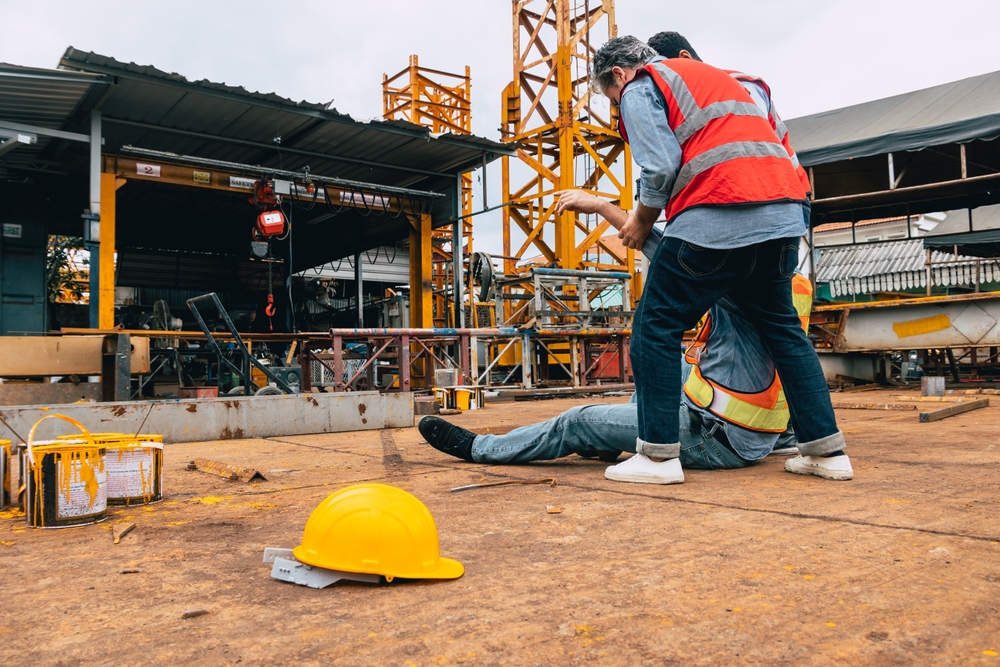Millions of American workers suffer workplace injuries each year, ranging from minor strains to serious accidents. Understanding the most common types of workplace injuries helps employees recognize hazards, take preventive measures, and know their rights when accidents occur. In Pennsylvania, workers' compensation covers a wide range of injury types across all industries, but navigating the claims process can be complicated. Speaking with an experienced workers’ compensation attorney ensures injured employees receive the guidance they need to protect their rights and secure the benefits they deserve.
Workplace injuries don't discriminate by industry or experience level. Whether you work in construction, healthcare, manufacturing, or an office setting, certain injury patterns tend to emerge. Recognizing these patterns helps both workers and employers create safer work environments while helping injured workers receive appropriate care and benefits.
Key Takeaways
- Overexertion and repetitive motion injuries account for the largest percentage of workplace injuries
- Slips, trips, and falls remain the second most common cause of work-related injuries
- Industry-specific hazards create unique injury risks that require targeted prevention strategies
- Proper reporting and documentation protect your rights regardless of injury type
- Even seemingly minor injuries warrant attention and proper reporting
Overexertion and Repetitive Motion Injuries
Overexertion injuries typically top the list of most common workplace injuries, affecting workers across virtually every industry. These injuries occur when workers push their bodies beyond comfortable limits through lifting, pushing, pulling, or carrying activities. The lower back bears the brunt of these injuries, though shoulders, knees, and other joints frequently suffer damage.
Repetitive motion injuries develop gradually through repeated movements over time. Carpal tunnel syndrome, tendinitis, and bursitis plague workers who perform the same motions throughout their shifts. Office workers typing all day, assembly line workers making repeated movements, and cashiers scanning items all face these risks.
These injuries often start subtly with minor discomfort that workers ignore. Over time, minor pain evolves into chronic conditions that may require extensive treatment. Early reporting and ergonomic adjustments can prevent permanent damage in many cases. Common overexertion and repetitive strain injuries include:
- Lower back strains from lifting or bending
- Rotator cuff injuries from overhead work
- Carpal tunnel syndrome from repetitive hand movements
- Tennis elbow from repeated arm motions
- Herniated discs from heavy lifting
Workers in physically demanding jobs face obvious overexertion risks, but office workers shouldn't underestimate their vulnerability. Poor posture, inadequate workstation setup, and prolonged sitting create significant injury risks even in seemingly safe environments.
Slips, Trips, and Falls

Falls typically represent the second most common category of workplace injuries, causing everything from minor bruises to fatal accidents. These incidents occur in every work environment, from construction sites to retail stores. Height-related falls cause the most severe injuries, but same-level falls create significant problems too.
Wet floors, uneven surfaces, poor lighting, and cluttered walkways contribute to fall risks. Weather conditions add complications for outdoor workers, while indoor workers face hazards from spilled liquids, loose carpeting, or unmarked elevation changes. Pennsylvania's variable weather creates additional seasonal risks.
Fall-related injuries vary widely in severity and type. A simple slip might cause a sprained ankle, while a fall from height could result in multiple fractures or head trauma. Common injuries from workplace falls include:
- Fractures, particularly wrists, ankles, and hips
- Head injuries ranging from mild concussions to traumatic brain injuries
- Spinal cord injuries with potential paralysis
- Soft tissue injuries like sprains and strains
- Cuts and lacerations from landing on sharp objects
Prevention requires constant vigilance from both employers and workers. Good housekeeping, proper footwear, adequate lighting, and clear marking of hazards significantly reduce fall risks. Workers should report hazardous conditions immediately rather than waiting for accidents to occur.
The recovery process and how long a workers’ compensation claim takes may also depend on the severity of these injuries
Struck-By and Caught-Between Injuries
Workers in construction, manufacturing, and warehousing face significant risk of struck-by and caught-between injuries. These accidents occur when workers are hit by falling objects, moving equipment, or vehicles, or when body parts become trapped between objects or machinery.
Struck-by injuries range from minor bruises to fatal crushing injuries. Hard hats prevent many head injuries, but workers remain vulnerable to objects striking other body parts. Caught-between injuries often involve machinery, creating risks for amputation, crushing injuries, or death.
These injury types require comprehensive safety protocols, including proper machine guarding, lockout/tagout procedures, and personal protective equipment. Workers must maintain awareness of their surroundings and follow safety procedures consistently. These cases are often contested by insurers, sometimes leading to denied workers’ comp claims.
Vehicle-Related Workplace Injuries
Vehicle accidents cause numerous workplace injuries, affecting not just professional drivers but any worker who drives for job duties. Delivery drivers, sales representatives, construction workers traveling between sites, and healthcare workers making home visits all face vehicle-related risks.
These accidents cause diverse injuries including whiplash, fractures, head injuries, and internal trauma. Even minor fender-benders can result in soft tissue injuries that require extensive treatment. Pennsylvania workers injured in vehicle accidents while performing work duties qualify for workers' compensation regardless of fault.
In some cases, these incidents may also involve workers’ comp and third-party lawsuits when another driver is responsible.
Industry-Specific Injury Patterns

Different industries face unique injury risks based on their work environments and tasks. Understanding industry-specific patterns helps workers recognize and prevent common hazards in their fields.
Healthcare workers experience high rates of back injuries from patient handling, needlestick injuries, and workplace violence. Manufacturing workers face machinery-related injuries, hearing loss from noise exposure, and respiratory issues from airborne contaminants. Construction workers deal with fall risks, struck-by hazards, and electrocution dangers.
Office workers might seem safer but face their own injury patterns. Ergonomic injuries from poor workstation setup, eye strain from computer use, and even slip-and-fall accidents in office buildings create significant risks. No workplace is entirely hazard-free. Knowing when to hire a Pennsylvania workers’ compensation lawyer can help workers in any industry protect their benefits.
Reporting and Documentation
Proper reporting helps to protect your rights regardless of injury type. Pennsylvania law requires reporting work injuries within 21 days for optimal protection, though workers have up to 120 days. Understanding how to file a workers’ comp claim and reporting all injuries, even those that seem minor initially, ensures your eligibility for benefits.
Document injuries thoroughly, including how the injury occurred, witnesses who were present, and any immediate symptoms. Take photographs of hazardous conditions if possible. Seek medical attention promptly and inform healthcare providers the injury occurred at work. Following these steps helps protect your rights and supports your access to benefits if injuries worsen.
FAQ for Most Common Types of Workplace Injuries
Are all workplace injuries covered by workers' compensation?
Workplace injuries may qualify for workers' compensation in Pennsylvania if they happen while performing job duties. This can include both sudden accidents and conditions that develop over time, such as carpal tunnel syndrome. In most situations, workers may be eligible for benefits even if no one was directly at fault.
What if my injury seems minor at first?
Report all injuries immediately, even minor ones. Many serious conditions start with mild symptoms, especially if you already had a preexisting condition, workers’ comp in Pennsylvania may still cover. Early reporting protects your rights if the injury worsens and establishes a clear connection to work activities.
Do I need witnesses to prove my workplace injury?
While witnesses strengthen claims, they're not always required. Your credible testimony, medical evidence, and prompt reporting often suffice. Security footage, accident reports, and consistent medical documentation also support claims without witnesses.
Can I receive workers' comp for stress-related injuries?
Pennsylvania recognizes physical injuries caused by work-related stress, such as heart attacks or strokes triggered by work events. Purely psychological injuries have stricter requirements and typically need extraordinary circumstances beyond normal work stress.
How long do I have to miss work to receive benefits?
Pennsylvania workers' compensation pays wage loss benefits after missing more than seven days of work. If you miss 14 or more days, benefits retroactively cover the first week. Medical benefits begin immediately regardless of lost time.
Protecting Yourself From Workplace Injuries

Understanding the most common types of workplace injuries empowers workers to recognize hazards and take preventive action. While accidents happen despite best efforts, knowledge and vigilance significantly reduce risks. When injuries do occur, proper reporting and documentation ensure access to necessary medical care and benefits.
Every workplace presents unique hazards, but common injury patterns persist across industries. Stay alert to these risks, follow safety protocols, and report unsafe conditions before accidents occur. Your health and safety depend on proactive prevention combined with knowing your rights when injuries happen.
If you've suffered a workplace injury in Pennsylvania and need guidance navigating the workers' compensation system, contact Kaufman Workers' Compensation Law at (267) 626-2973. From our offices in Abington and Philadelphia, we serve injured workers throughout Montgomery County and Southeastern Pennsylvania.
Jenifer Kaufman is a certified workers' compensation specialist in Pennsylvania—earning this credential in 2013, the very first year it became available, and renewing it in 2018. With our unique standby counsel service, you can have Jenifer Kaufman in your back pocket ready to help if problems arise, with no fee unless filing a claim petition—Pennsylvania's formal process for resolving disputes—becomes necessary. We help injured workers understand their rights and navigate the workers' compensation system to pursue the benefits available under Pennsylvania law.